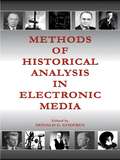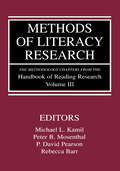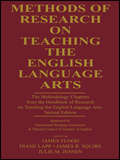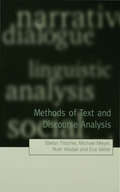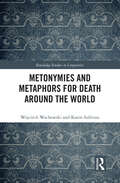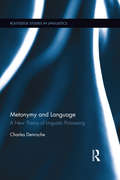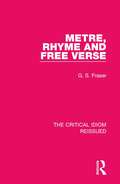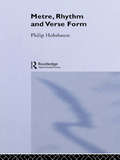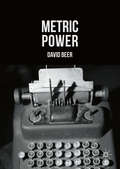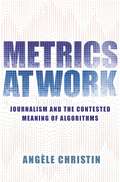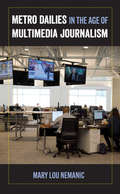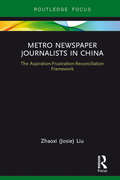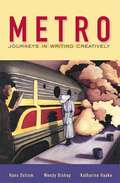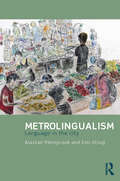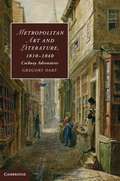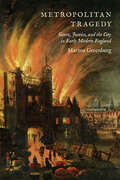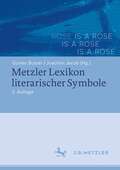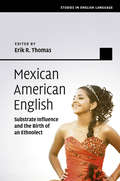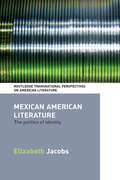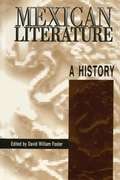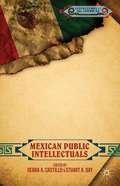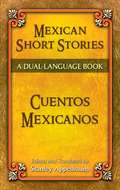- Table View
- List View
Methods of Historical Analysis in Electronic Media (Routledge Communication Series)
by Donald G. GodfreyMethods of Historical Analysis in Electronic Media provides a foundation for historical research in electronic media by addressing the literature and the methods--traditional and the eclectic methods of scholarship as applied to electronic media. It is about history--broadcast electronic media history and history that has been broadcast, and also about the historiography, research written, and the research yet to be written.Divided into five parts, this book:*addresses the challenges in the application of the historical methods to broadcast history;*reviews the various methods appropriate for electronic-media research based on the nature of the object under study;*suggests new approaches to popular historical topics;*takes a broad topical look at history in broadcasting; and*provides a broad overview of what has been accomplished, a historian's challenges, and future research.Intended for students and researchers in broadcast history, Methods of Historical Analysis in Electronic Media provides an understanding of the qualitative methodological tools necessary for the study of electronic media history, and illustrates how to find primary sources for electronic media research.
Methods of Literacy Research: The Methodology Chapters From the Handbook of Reading Research, Volume III
by P. David Pearson Michael L. Kamil Peter B. Mosenthal Rebecca BarrIn this volume, 10 reviews of significant reading research methodologies are reprinted from the Handbook of Reading Research, Volume III. The editors have judged that these specific methodologies have had great impact on reading research since the publication of Volume II in 1991. This text is especially well-suited for use in upper-level undergraduate and graduate-level reading research methods courses.
Methods of Murder
by Elena M. PastThe first extended analysis of the relationship between Italian criminology and crime fiction in English, Methods of Murder examines works by major authors both popular, such as Gianrico Carofiglio, and canonical, such as Carlo Emilio Gadda.Many scholars have argued that detective fiction did not exist in Italy until 1929, and that the genre, which was considered largely Anglo-Saxon, was irrelevant on the Italian peninsula. By contrast, Past traces the roots of the twentieth-century literature and cinema of crime to two much earlier, diverging interpretations of the criminal: the bodiless figure of Cesare Beccaria's Enlightenment-era On Crimes and Punishments, and the biological offender of Cesare Lombroso's positivist Criminal Man.Through her examinations of these texts, Past demonstrates the links between literary, philosophical, and scientific constructions of the criminal, and provides the basis for an important reconceptualization of Italian crime fiction.
Methods of Research on Teaching the English Language Arts: The Methodology Chapters From the Handbook of Research on Teaching the English Language Arts, Sponsored by International Reading Association & National Council of Teachers of English
by James Flood Diane Lapp James R. Squire Julie M. JensenThis text makes available in a concise format the chapters comprising the research methodology section of the Handbook of Research on Teaching the English Language Arts, Second Edition. An introduction, designed to give K-12 teachers an understanding of the basic categories and functions of research in teaching, is followed by chapters addressing teacher professionalism and the rise of "multiple literacies"; empirical research; longitudinal studies; case studies; ethnography; teacher research; teacher inquiry into literacy, social justice, and power; synthesis research; fictive representation; and contemporary methodological issues and future direction in research on the teaching of English. Methods of Research on Teaching the English Language Arts is well-suited for use in upper-level undergraduate and graduate-level literacy research methods courses.
Methods of Text and Discourse Analysis: In Search of Meaning
by Michael Meyer Ruth Wodak Eva Vetter Stefan Titscher'This volume is the most comprehensive overview to date of sociologically orientated approaches to text and discourse analysis and is worth reading even for those who are interested only in purely linguistiv approaches to text and discourse. Its main merit, I think, is that it intorduces approaches which up to now have hardley been admitted into the universe of scientific discourse' - Discourse Studies Methods of Text and Discourse Analysis provides the most comprehensive overview currently available of linguistic and sociological approaches to text and discourse analysis. Among the 10 linguistic and sociological models surveyed in this book some of the more important are Grounded Theory, Content Analysis, Conversation Analysis and Critical Discourse Analysis. The book presents each approach according to a standardised format, which allows for direct systematic comparisons. The fully annotated lists of sources provide readers with an additional means of evaluation of the competing analytical methods. Interdisciplinary and international in its aims, Methods of Text and Discourse Analysis suggests the benefits both linguists and sociologists will derive from a more intimate knowledge of each others' methods and procedures.
Metonymies and Metaphors for Death Around the World (Routledge Studies in Linguistics)
by Karen Sullivan Wojciech WachowskiThis book reflects on the ways in which metaphor and metonymy are used conceptually and linguistically to mitigate the more difficult dimensions of death and dying, setting out a unique line of research within Conceptual Metaphor Theory.// The volume argues that metaphor and metonymic descriptions of death and dying reflect taboos, concealment, and other considerations not found in figurative descriptions of life, producing distinct forms of euphemism, frames, and mental spaces particular to conceptualisations of death. The first part focuses on the more palatable concepts which metaphorically structure and help to better understand death. The second section takes a closer look at metonymy to illuminate the ways in which it allows a person to zoom in on death’s more inoffensive dimensions or zoom out on its more troubling aspects. A wide range of classical and modern examples from European, Asian, Australian Aboriginal, and African languages and cultures showcase points of overlap and divergence. // Opening up new lines of inquiry into research on death and dying and offering a linguistically-focused complement to anthropological and religious studies on the topic, this book will be of interest to scholars in cognitive linguistics, sociolinguistics, cross-cultural communication, and cultural studies.
Metonymy and Language: A New Theory of Linguistic Processing (Routledge Studies in Linguistics)
by Charles DenrocheMetonymy and Language presents a new theory of language and communication in which the central focus is on the concept of metonymy, the recognition of partial matches and overlaps. Through the use of original data sets and rigorous primary research, Denroche characterizes metonymy as key to understanding why language is so ‘fit for purpose’ and how it achieves such great subtlety and flexibility. This study develops the notion of ‘metonymic competence’ and demonstrates that metonymic behavior is often pursued for its own sake in recreational activities, such as quizzes, puzzles and play, and shows the possible impact of the application of metonymic processing theory to professional fields, such as language teaching and translator training. Furthermore, it proposes a research approach with metonymy at its center, ‘metonymics,’ which Denroche suggests could provide a powerful framework for addressing issues in numerous fields of practice in the arts and sciences.
Metonymy: Hidden Shortcuts in Language, Thought and Communication
by Jeannette Littlemore'Metonymy' is a type of figurative language used in everyday conversation, a form of shorthand that allows us to use our shared knowledge to communicate with fewer words than we would otherwise need. 'I'll pencil you in' and 'let me give you a hand' are both examples of metonymic language. Metonymy serves a wide range of communicative functions such as textual cohesion, humour, irony, euphemism and hyperbole - all of which play a key role in the development of language and discourse communities. Using authentic data throughout, this book shows how metonymy operates, not just in language, but also in gesture, sign language, art, music, film and advertising. It explores the role of metonymy in cross-cultural communication, along with the challenges it presents to language learners and translators. Ideal for researchers and students in linguistics and literature, as well as teachers and general readers interested in the art of communication.
Metre, Rhyme and Free Verse (The Critical Idiom Reissued #7)
by G. S. FraserFirst published in 1970, this work outlines the principles of English prosody in a way that will enable the reader to recognise and scan any piece of English verse. It illustrates the close relationship between English speech patterns and verse patterns, and the primary importance of the phenomenon of stress. It also discusses the suitability of various kinds of metrical pattern for various kinds of poetic effect. This book will be of interest to those studying poetry and English literature.
Metre, Rhythm and Verse Form (The New Critical Idiom)
by Philip HobsbaumPoetry criticism is a subject central to the study of literature. However, it is laden with technical terms that, to the beginning student, can be both intimidating and confusing. Philip Hobsbaum provides a welcome remedy, illuminating terms ranging from the iambus to the bob-wheel stanza, and forms from the Spenserian sonnet to modern 'rap', with clarity and comprehensiveness. It is an essential guide through the terminology which will be invaluable reading for undergraduates new to the subject.
Metric Power
by David BeerThis book examines the powerful and intensifying role that metrics play in ordering and shaping our everyday lives. Focusing upon the interconnections between measurement, circulation and possibility, the author explores the interwoven relations between power and metrics. He draws upon a wide-range of interdisciplinary resources to place these metrics within their broader historical, political and social contexts. More specifically, he illuminates the various ways that metrics implicate our lives - from our work, to our consumption and our leisure, through to our bodily routines and the financial and organisational structures that surround us. Unravelling the power dynamics that underpin and reside within the so-called big data revolution, he develops the central concept of Metric Power along with a set of conceptual resources for thinking critically about the powerful role played by metrics in the social world today.
Metrics at Work: Journalism and the Contested Meaning of Algorithms
by Angele ChristinThe starkly different ways that American and French online news companies respond to audience analytics and what this means for the future of newsWhen the news moved online, journalists suddenly learned what their audiences actually liked, through algorithmic technologies that scrutinize web traffic and activity. Has this advent of audience metrics changed journalists’ work practices and professional identities? In Metrics at Work, Angèle Christin documents the ways that journalists grapple with audience data in the form of clicks, and analyzes how new forms of clickbait journalism travel across national borders.Drawing on four years of fieldwork in web newsrooms in the United States and France, including more than one hundred interviews with journalists, Christin reveals many similarities among the media groups examined—their editorial goals, technological tools, and even office furniture. Yet she uncovers crucial and paradoxical differences in how American and French journalists understand audience analytics and how these affect the news produced in each country. American journalists routinely disregard traffic numbers and primarily rely on the opinion of their peers to define journalistic quality. Meanwhile, French journalists fixate on internet traffic and view these numbers as a sign of their resonance in the public sphere. Christin offers cultural and historical explanations for these disparities, arguing that distinct journalistic traditions structure how journalists make sense of digital measurements in the two countries.Contrary to the popular belief that analytics and algorithms are globally homogenizing forces, Metrics at Work shows that computational technologies can have surprisingly divergent ramifications for work and organizations worldwide.
Metro Dailies in the Age of Multimedia Journalism
by Mary Lou NemanicThe death of the daily newspaper in the internet age has been predicted for decades. While print newspapers are struggling from drops in advertising and circulation, their survival has been based on original reporting. Instead of a death knell, metro dailies are experiencing an identity crisis—a clash between traditional print journalism’s formality and detail and digital journalism’s informality and brevity. In Metro Dailies in the Age of Multimedia Journalism, Mary Lou Nemanic provides in-depth case studies of five mid-size city newspapers to show how these publications are adapting to the transition from print-only to multiplatform content delivery—and how newsroom practices are evolving to address this change. She considers the successes when owners allow journalists to manage their newspapers—to ensure production of quality journalism under the protection of newspaper guilds—as well as how layoffs and resource cutbacks have jeopardized quality standards. Arguing for an integrated approach in which print and online reporting are considered complementary and visual journalism is emphasized across platforms, Nemanic suggests that there is a future for the endangered daily metro newspaper.
Metro Newspaper Journalists in China: The Aspiration-Frustration-Reconciliation Framework (Routledge Focus on Journalism Studies)
by Zhaoxi (Josie) LiuThis book explores how journalists at local metro papers in a south-western China metropolis give meaning to their work and how these meanings are shaped by the specific social environment within which these journalists operate. These metro papers provide the bulk of daily news to the general public in China, yet are often understudied compared to the country’s party news outlets. Informed by fieldwork in four metro newspapers, the book puts forward a grounded theory for exploring journalists’ occupational culture: the aspiration-frustration-reconciliation framework.
Metro: Journeys in Writing Creatively
by Wendy Bishop Katharine Haake Hans A. OstromMetro is a unique multi-genre creative writing book that provides exercises and prompts to help readers move beyond terms and concepts to active writing. By using "guided writing," the authors help the reader through the creative processes in fiction, poetry, drama, and creative nonfiction. A mini-anthology with relevant exercises makes this sourcebook complete. For anyone interested in enhancing their creative writing skills.
Metrolingualism: Language in the City
by Alastair Pennycook Emi OtsujiThis book is about language and the city. Pennycook and Otsuji introduce the notion of ‘metrolingualism’, showing how language and the city are deeply involved in a perpetual exchange between people, history, migration, architecture, urban landscapes and linguistic resources. Cities and languages are in constant change, as new speakers with new repertoires come into contact as a result of globalization and the increased mobility of people and languages. Metrolingualism sheds light on the ordinariness of linguistic diversity as people go about their daily lives, getting things done, eating and drinking, buying and selling, talking and joking, drawing on whatever linguistic resources are available. Engaging with current debates about multilingualism, and developing a new way of thinking about language, the authors explore language within a number of contemporary urban situations, including cafés, restaurants, shops, streets, construction sites and other places of work, in two diverse cities, Sydney and Tokyo. This is an invaluable look at how people of different backgrounds get by linguistically. Metrolingualism: Language in the city will be of special interest to advanced undergraduate/postgraduate students and researchers of sociolinguistics and applied linguistics.
Metropolitan Art and Literature, 1810-1840
by Gregory DartGregory Dart expands upon existing notions of Cockneys and the 'Cockney School' in the late Romantic period by exploring some of the broader ramifications of the phenomenon in art and periodical literature. He argues that the term was not confined to discussion of the Leigh Hunt circle, but was fast becoming a way of gesturing towards everything in modern metropolitan life that seemed discrepant and disturbing. Covering the ground between Romanticism and Victorianism, Dart presents Cockneyism as a powerful critical currency in this period, which helps provide a link between the works of Leigh Hunt and Keats in the 1810s and the early works of Charles Dickens in the 1830s. Through an examination of literary history, art history, urban history and social history, this book identifies the early nineteenth century figure of the Cockney as the true ancestor of modernity.
Metropolitan Tragedy
by Marissa GreenbergBreaking new ground in the study of tragedy, early modern theatre, and literary London, Metropolitan Tragedy demonstrates that early modern tragedy emerged from the juncture of radical changes in London's urban fabric and the city's judicial procedures. Marissa Greenberg argues that plays by Shakespeare, Milton, Massinger, and others rework classical conventions to represent the city as a locus of suffering and loss while they reflect on actual sources of injustice in sixteenth- and seventeenth-century London: structural upheaval, imperial ambition, and political tyranny.Drawing on a rich archive of printed and manuscript sources, including numerous images of England's capital, Greenberg reveals the competing ideas about the metropolis that mediated responses to theatrical tragedy. The first study of early modern tragedy as an urban genre, Metropolitan Tragedy advances our understanding of the intersections between genre and history.
Metzler Lexikon literarischer Symbole
by Joachim Jacob Günter Butzer500 Artikel von „Abend“ bis „Zypresse“: Dieses Lexikon versammelt die wichtigsten Symbole der abendländischen Literatur und zeichnet ihre Geschichte an exemplarischen Belegstellen nach. Zahlen, Farben, Pflanzen, Tiere, Orte, Räume, Dinge, Tages- und Jahreszeiten u.v.m. werden jeweils in ihren zentralen Bedeutungen von der griechisch-römischen und biblischen bis in die gegenwärtige Literatur beschrieben.Die dritte Auflage hat neben 30 neuen Artikeln ein ausführliches Bedeutungsregister, das ermöglicht, von Bedeutungen ausgehend die für diese verwendeten Symbole zu ermitteln.
Mexican American English: Substrate Influence and the Birth of an Ethnolect (Studies in English Language)
by Erik R. ThomasResponding to the need for a comprehensive treatment of Mexican American English and its varied influences across multiple generations, this volume provides true insight into how language contact triggers language change, and illustrates previously under-recognised links to ethnolects of other migrant groups in different parts of the world. It demonstrates how the variety begins with Spanish interference features but evolves into a stable variety over time by filtering out some of the interference features and responding to forces such as exploitation of its speakers, education, and the need to develop solidarity. A large number of linguistic variables from multiple realms of language are analysed that provide a truly balanced picture of the divisions within the community across a range of linguistic levels such as syntax, phonology, prosody, accent, dialect, and sociolinguistics.
Mexican American Literature: The Politics of Identity (Routledge Transnational Perspectives on American Literature #Vol. 5)
by Elizabeth JacobsPresenting an up-to-date critical perspective as well as a cultural, political and historical context, this book is an excellent introduction to Mexican American literature, affording readers the major novels, drama and poetry. This volume presents fresh and original readings of major works, and with its historiographic and cultural analyses, impressively delivers key information to the reader.
Mexican Ballads, Chicano Poems: History and Influence in Mexican-American Social Poetry
by José E. LimónMexican Ballads, Chicano Poems combines literary theory with the personal engagement of a prominent Chicano scholar. Recalling his experiences as a student in Texas, José Limón examines the politically motivated Chicano poetry of the 60s and 70s. He bases his analyses on Harold Bloom's theories of literary influence but takes Bloom into the socio-political realm. Limón shows how Chicano poetry is nourished by the oral tradition of the Mexican corrido, or master ballad, which was a vital part of artistic and political life along the Mexican-U.S. border from 1890 to 1930. Limón's use of Bloom, as well as of Marxist critics Raymond Williams and Fredric Jameson, brings Chicano literature into the arena of contemporary literary theory. By focusing on an important but little-studied poetic tradition, his book challenges our ideas of the American canon and extends the reach of Hispanists and folklorists as well.
Mexican Literature: A History
by David William FosterMexico has a rich literary heritage that extends back over centuries to the Aztec and Mayan civilizations. This major reference work surveys more than five hundred years of Mexican literature from a sociocultural perspective. More than merely a catalog of names and titles, it examines in detail the literary phenomena that constitute Mexico's most significant and original contributions to literature.<P> Recognizing that no one scholar can authoritatively cover so much territory, David William Foster has assembled a group of specialists, some of them younger scholars who write from emerging trends in Latin American and Mexican literary scholarship. The topics they discuss include pre-Columbian indigenous writing (Joanna O'Connell), Colonial literature (Lee H. Dowling), Romanticism (Margarita Vargas), nineteenth-century prose fiction (Mario Martín Flores), Modernism (Bart L. Lewis), major twentieth-century genres (narrative, Lanin A. Gyurko; poetry, Adriana García; theater, Kirsten F. Nigro), the essay (Martin S. Stabb), literary criticism (Daniel Altamiranda), and literary journals (Luis Peña). Each essay offers detailed analysis of significant issues and major texts and includes an annotated bibliography of important critical sources and reference works.
Mexican Public Intellectuals
by Debra A. Castillo Stuart A. DayIn Mexico, the participation of intellectuals in public life has always been extraordinary, and for many the price can be high. Highlighting prominent figures that have made incursions into issues such as elections, human rights, foreign policy, and the drug war, this volume paints a picture of the ever-changing context of Mexican intellectualism.
Mexican Short Stories / Cuentos mexicanos: A Dual-Language Book
by Stanley AppelbaumGreatly influenced by Europe's nineteenth-century literary trends, Mexico's writers crafted some of the most phenomenal prose fiction in Spanish America. This collection offers a rich sampling of significant Mexican short stories published from 1843 to 1918. Nine different tales range from the realism of López Portillo's "Reloj sin dueño" and the modernismo saturating Gutiérrez Nájera's "La mañana de San Juan" to the historical accuracy of Riva Palacio's "Las mulas de Su Excelencia" and the vivid romanticism of "Amor secreto" by Manuel Payno, named the "father of Mexican short stories." Each story appears in its original Spanish text with expert English translations on each facing page. This dual-language edition features a fascinating new introduction and ample footnotes. An easy-reading pleasure for lovers of fine Spanish-language literature, it is also a valuable educational aid for students and teachers.
